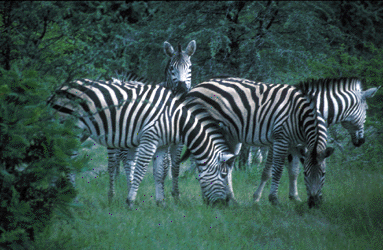Introduction
 This page has been mothballed.
This page has been mothballed.
It is no longer being updated but we've left it here for reference.
 Population increases in
the majority of countries in Sub-Saharan Africa have led to an increased demand
for land in rural areas. In semi-arid areas of Eastern and Southern Africa land
which previously was classed as marginal, because of poor soil quality and/or
lack of rainfall, is now being incorporated into agricultural production,
primarily extensive livestock grazing. This can result in land degradation and
conflicts in land use between pastoralism and wildlife conservation. The future
of much of this marginal land lies in the balance, but integrated land use
systems implemented through community-based natural resource management policy
are likely to be the way forward.
Population increases in
the majority of countries in Sub-Saharan Africa have led to an increased demand
for land in rural areas. In semi-arid areas of Eastern and Southern Africa land
which previously was classed as marginal, because of poor soil quality and/or
lack of rainfall, is now being incorporated into agricultural production,
primarily extensive livestock grazing. This can result in land degradation and
conflicts in land use between pastoralism and wildlife conservation. The future
of much of this marginal land lies in the balance, but integrated land use
systems implemented through community-based natural resource management policy
are likely to be the way forward.
KEY ISSUES
- Livestock production in communal area rangelands
- Livestock/wildlife interactions and development of integrated land use
- Wildlife conservation and management, both within and outside national parks
- Socio-economic implications of land use and the development of community-based natural resource management
 WE CAN
OFFER:
WE CAN
OFFER:
Central to the strategy for linking our scientific expertise with the development issues relevant to Africa is the development of science-based natural resource management plans for livestock and wildlife.
- Expertise and experience in monitoring animal production in extensive grazing systems, using innovative techniques
- Development of grazing management plans and feed evaluation
- Expertise and experience in developing multiple-species grazing systems including livestock and wildlife and the development of decision support tools for the integrated management of livestock and wildlife
- Expertise and experience in the development of decision support tools to estimate wildlife carrying capacity and sustainable utilization levels. Utilization of telemetry and GPS technology to measure animal movements. Use of GIS to develop habitat maps and animal distribution
- Experience in the socio-economic implications of different land use types and the implementation of communal based natural resource management schemes, both for livestock and wildlife
SOME RECENT PROJECTS
- Natural resource management within a multispecies system in the mid Zambezi Valley: implications for sustainable development in dry lands areas of Southern Africa (European Commission)
- Participatory development of community based management plans for livestock feed resources in the semi-arid areas of Zimbabwe (DFID)
- Competition between species in the African carnivore guild (Beit Trust and Aberdeen University)
- Providing training for MSc students in the tropical resource ecology programme at the University of Zimbabwe (European Commission)
- The development of science-based understanding of the foraging behaviour of domestic ruminants in the eastern cape region of South Africa (Royal Society)
- Environmental variability and productivity of semi-arid grazing (DFID)
- Livestock/wildlife interactions in areas of Tse-Tse fly elimination and prevalence (DFID)
POST GRADUATE STUDENT RESEARCH PROJECTS:
- The behaviour and ecology of a population of African wild dogs in the absence of their two main competitors.
- Diet selection by cattle and goats on savanna bushland in southern Zimbabwe
- Competition and co-existence in the African carnivore guild
- Livestock/primary production relationships in the mid-Zambezi valley

